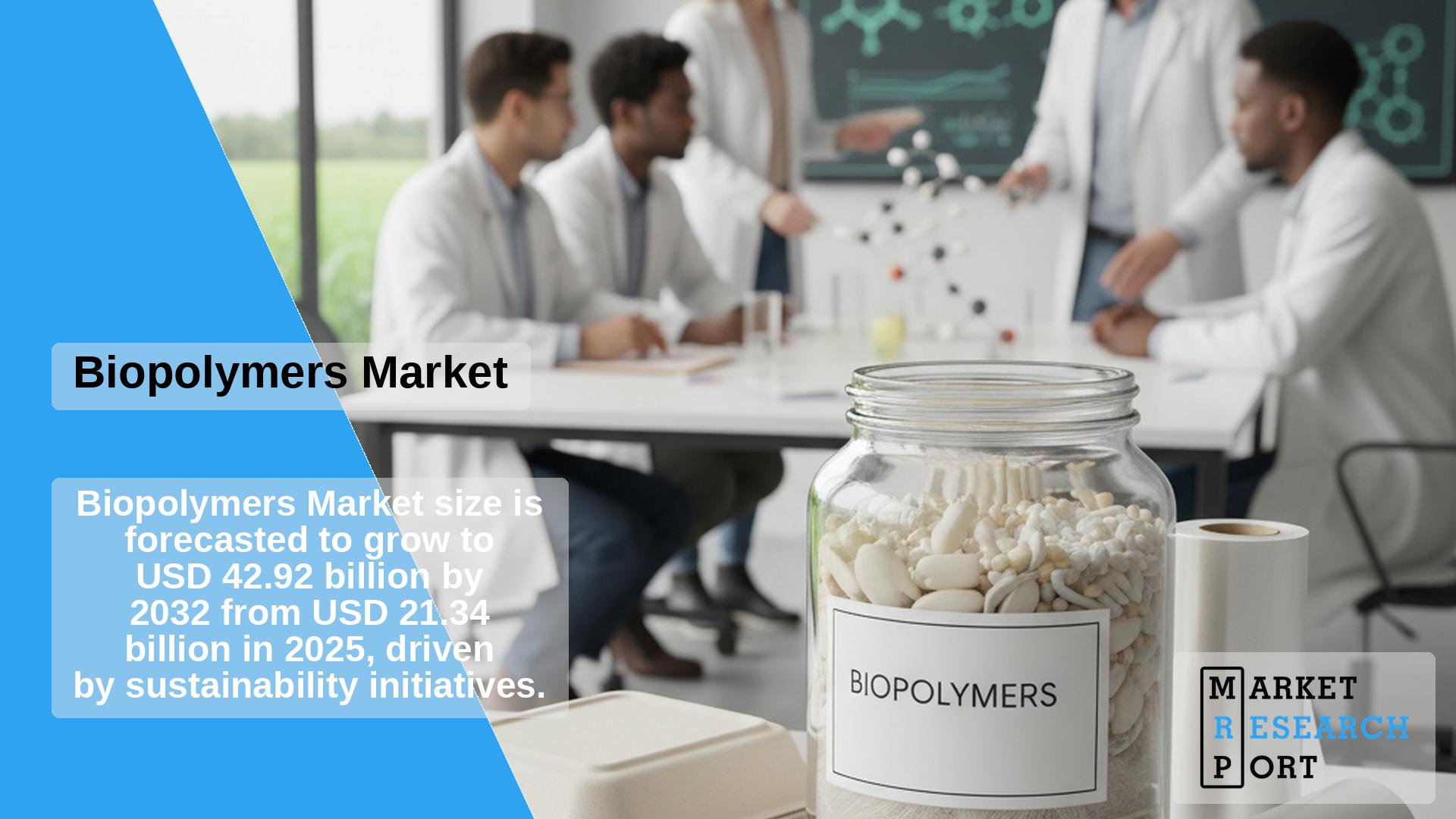
The global biopolymers market reached USD 20.54 billion in 2025 and is expected to attain USD 43.32 billion by 2030, growing at a CAGR of 9.8% from 2025 to 2030. The market growth is primarily driven by the rising adoption of environmentally sustainable packaging materials and increasing awareness about reducing plastic waste. Strong governmental initiatives promoting biodegradable plastics and mounting consumer demand for renewable alternatives have accelerated market expansion worldwide.
Growing concerns about single-use plastics and their environmental impact are leading corporations and governments to adopt biopolymers across multiple sectors. These bio-based materials, derived from renewable feedstocks such as sugarcane, corn starch, and cellulose, offer superior biodegradability and significantly lower carbon emissions compared to traditional plastics. Their expanding applications in food packaging, pharmaceuticals, healthcare, and textiles are further propelling global market demand.
Consumers increasingly prefer sustainable and compostable packaging options, while governmental restrictions on petroleum-based plastic products continue to reinforce the ongoing transition. Nevertheless, the relatively high manufacturing and raw material costs remain a challenge, affecting large-scale commercialization, though ongoing research efforts are expected to improve cost efficiency and compatibility across end-use industries.
The packaging sector accounted for the largest share of 39.2% in 2025, driven by surging demand for biodegradable food packaging, compostable films, and single-use alternatives. Global consumer brands are rapidly integrating bio-based packaging in response to sustainability pledges and stricter waste management regulations. Biopolymers also play an expanding role in consumer goods production, aligning with the growing trend toward sustainable materials within electronics, appliances, and personal care products.
In the automotive sector, advancements in lightweight, high-strength biopolymers have opened up new application areas, reducing vehicle weight and improving fuel efficiency. The trend of material innovation in biodegradable composites and heat-resistant compounds is also supporting increased adoption across industrial designs.
The bottle segment maintained its lead with 30.6% market share in 2025. The growing transition to renewable plastics for beverage packaging—such as polylactic acid (PLA)-based bottles—has significantly contributed to this leadership. Bioplastics are increasingly replacing conventional PET due to their recyclability and lower environmental footprint.
Beyond packaging, biopolymers are being heavily utilized in agriculture, coatings, seed treatment, and biomedical devices. Their biocompatibility and degradability also make them ideal for medical implants and controlled drug-release systems, helping minimize invasive procedures and promote natural bioabsorption over time.
Biodegradable polyesters continued to dominate the market, with 46.5% revenue share in 2025. Their widespread adoption in packaging, textiles, and agricultural products stems from their superior compostability and durability. The improved strength and biodegradation versatility of polybutylene succinate (PBS) and polyhydroxyalkanoates (PHA) further strengthen this segment’s long-term growth potential.
Bio-based polyethylene (Bio-PE) and bio-polyethylene terephthalate (Bio-PET) also represent rapidly developing categories, contributing to emission reduction and resource renewability. Additionally, polylactic acid (PLA), derived from corn starch, remains one of the most accessible and scalable biopolymer types due to its versatility and commercial maturity.
Asia Pacific remained the leading regional market, capturing over 38.4% share in 2025. Countries such as China, India, and Japan continue to invest heavily in bio-based manufacturing infrastructure and R&D programs focused on sustainable material innovation. Abundant biomass resources, inexpensive feedstocks, and supportive government regulations are promoting significant biopolymer production increases across the region.
In Europe, sustainability-driven legislation and circular economy policies are accelerating the adoption of bioplastics and compostable materials, particularly within the packaging industry. Investments in advanced recycling facilities and collaborations among food and cosmetics producers contribute to robust market expansion. North America is also strengthening its position through strategic partnerships, with major packaging converters and resin producers investing in greener alternatives and expanding domestic production capacity.
Strategic innovations, new production plants, and mergers remain central to the competitive landscape. Companies focus on optimizing cost performance, expanding regional footprints, and accelerating eco-friendly product launches in line with growing customer and regulatory expectations.
| Report Attribute | Details |
| Market size value in 2025 | USD 20.54 billion |
| Revenue forecast in 2030 | USD 43.32 billion |
| Growth rate | CAGR of 9.8% from 2025–2030 |
| Historical data | 2019–2024 |
| Forecast period | 2025–2030 |
| Quantitative units | Volume in kilotons, revenue in USD billion, and CAGR from 2025 to 2030 |
| Report coverage | Market revenue, volume forecasts, company ranking, growth trends, and industry dynamics |
| Segments covered | Product, application, end-use, region |
| Regional scope | North America; Europe; Asia Pacific; Central & South America; Middle East & Africa |
| Country scope | U.S.; Canada; Mexico; Germany; UK; France; Italy; Spain; Netherlands; China; India; Japan; South Korea; Brazil; Argentina; Australia; Saudi Arabia; South Africa |
| Key companies profiled | BASF SE; ADM; DuPont; Novamont; Biopolymer Industries; Solanyl Biopolymers; Ecovia Renewables Inc.; BioPolymer GmbH & Co. KG; BIOTEC; BiologiQ, Inc. |
The report examines market performance across major product types, end-use industries, and geographical segments from 2019 through 2030.
How large is the biopolymers market in 2025?
The global biopolymers market was valued at USD 20.54 billion in 2025.
What is the expected market growth rate through 2030?
The market is anticipated to grow at a CAGR of 9.8% from 2025 to 2030, reaching USD 43.32 billion.
Which region leads the global biopolymers market?
Asia Pacific held the largest market share in 2025, accounting for over 38%, supported by growing renewable production capacity and government incentives for bio-based plastics.
Who are the key manufacturers in the market?
Major companies include BASF SE, DuPont, ADM, Novamont, BIOTEC, and Biopolymer Industries, among others.
What factors are driving global biopolymers market growth?
Increasing environmental regulation, bans on single-use plastics, and the rising popularity of biodegradable and renewable materials are the main growth accelerators in this market.